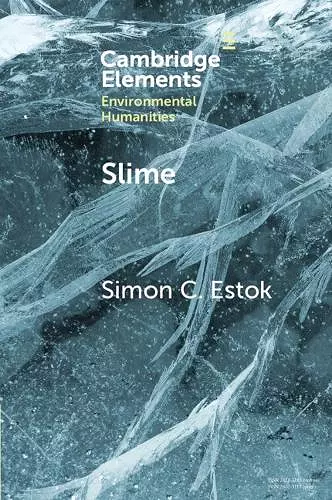Slime
An Elemental Imaginary
Format:Paperback
Publisher:Cambridge University Press
Published:9th Jan '25
Currently unavailable, and unfortunately no date known when it will be back
This paperback is available in another edition too:
- Hardback£55.00(9781009550703)

This Element discussed slime's importance; despite its ubiquity, there is a its dearth of discussions within the Environmental Humanities.
Slime has always stirred the imagination and evoked strong responses. This Element discusses slime as it defines the very parameters of life, from the primordial slime through which life began to the rot and slime to which life decomposes; despite slime's ubiquity, its dearth in discussions within the Environmental Humanities is pronounced.Slime has always stirred the imagination and evoked strong responses. It is as central to life and growth as to death, degeneration, and rot. Slime heals and cures; it also infects and kills. Slime titillates and terrifies. It fascinates children and is the horror in stories and the disgusting in fridges. Slime is part of good sex. Slime is also worryingly on the rise in the warming oceans. Engaging with slime is becoming more urgent because of its proliferation both in the seas and in our imaginations. Inextricable from racism, homophobia, sexism, and ecophobia, slime is the least theorized element and is indeed traditionally not even included among the elements. Things need to change. Addressing growing climate issues and honestly confronting matters associated with them depend to a very large degree on theorizing and thus understanding how people have thought and continue to think about slime.
'Arguing that as our ecophobic reactions to slime epitomize industrialized cultures' aversion to the natural world, Estok's new volume takes an intersectional, material ecofeminist, and ecocritical approach to slime, invoking perspectives from the primordial, elemental, and oceanic to the supernatural. Estok's widely-inclusive argument reveals slime's implicit associations with gender, race, class, and sexuality and offers new theoretical insights on slime and its history in horror narratives. The discussions about the responses of western cultures to slime are compelling and transdisciplinary. This is a must-read book for anyone in the Environmental Humanities.' Greta Gaard, Professor of English and Women/Gender/Sexuality Studies, University of Wisconsin, River Falls and author of Critical Ecofeminism (2017)
'Examining the secretions of our environmental imagination, Simon C. Estok engages with an element that is-as with all subsumed phenomena-always there and often overlooked. In a project that finds additional heft in this age of proliferating environmental crises, Estok's book, like its subject, seeps into the cracks of our cultural discourse, challenging conventional thinking and lending its unsettling texture to the slippery implications of environmental horror. From Coleridge to Sartre, Alien to Annihilation, Estok affirms the immediacy and consequence of the unctuous agency of slime.' Matthew Wynn Sivils, Professor of American Literature, Iowa State University
'This compact and densely packed book is full of phenomenological protein, slimy and nourishing. At once historical, scientific and philosophical/theoretical, Simon Estok has in a sense advanced our understanding of elementality as such: a category of being-environmental that precludes parsing into subject versus object, and therefore master versus slave. Slime is that rare and necessary thing, a political phenomenology.' Timothy Morton, author of Hell: In Search of a Christian Ecology
'Slime is an integral part of nature and the human body. There is no life without it, yet for most people it is an agent of transgression, disgust, and horror. Estok's slim volume on slime wonderfully succeeds in what makes for great non-fiction: by learning about its creeping subject, we understand much better both ourselves and our blind-spots in defining human relationships with the natural world. This is a necessary and-given the climate and other environmental crises-urgent book. Read it!' Susanne Wedlich, science journalist, author of A Natural History of Slime; curator of '(Bodily) Slimes,' an exhibition at the Berlin Museum of Medical History of the Charité (2025)
ISBN: 9781009550697
Dimensions: 229mm x 152mm x 4mm
Weight: 119g
72 pages